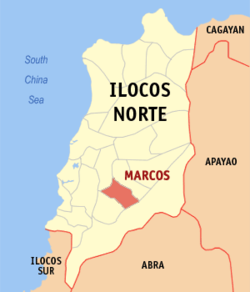Marcos | |
|---|---|
| Municipality of Marcos | |
 Map of Ilocos Norte with Marcos highlighted | |
Location within the Philippines | |
| Coordinates: 18°02′40″N 120°40′43″E / 18.0444°N 120.6786°E | |
| Country | Philippines |
| Region | Ilocos Region |
| Province | Ilocos Norte |
| District | 2nd district |
| Founded | June 22, 1963 |
| Named for | Mariano Marcos |
| Barangays | 13 (see Barangays) |
| Government | |
| • Type | Sangguniang Bayan |
| • mayor of Marcos[*] | Antonio V. Mariano |
| • Vice Mayor | Hilario B. Lorenzo |
| • Representative | Eugenio Angelo M. Barba |
| • Municipal Council | Members |
| • Electorate | 13,022 voters (2022) |
| Area | |
| • Total | 72.77 km2 (28.10 sq mi) |
| Elevation | 82 m (269 ft) |
| Highest elevation | 376 m (1,234 ft) |
| Lowest elevation | 27 m (89 ft) |
| Population (2020 census)[3] | |
| • Total | 18,010 |
| • Density | 250/km2 (640/sq mi) |
| • Households | 4,675 |
| Economy | |
| • Income class | 4th municipal income class |
| • Poverty incidence | 8.04 |
| • Revenue | ₱ 97.86 million (2020) |
| • Assets | ₱ 602.4 million (2020) |
| • Expenditure | ₱ 99.88 million (2020) |
| • Liabilities | ₱ 118.5 million (2020) |
| Service provider | |
| • Electricity | Ilocos Norte Electric Cooperative (INEC) |
| Time zone | UTC+8 (PST) |
| ZIP code | 2907 |
| PSGC | |
| IDD : area code | +63 (0)77 |
| Native languages | Ilocano Tagalog |
Marcos, officially the Municipality of Marcos (Ilocano: Ili ti Marcos; Filipino: Bayan ng Marcos), is a 4th class municipality in the province of Ilocos Norte, Philippines. According to the 2020 census, it has a population of 18,010.[3]
Formerly a part of Dingras, Ilocos Norte, Marcos was created on June 22, 1963, by Republic Act No. 3753, named in honor of Mariano Marcos, the father of former President Ferdinand Marcos. Marcos is 29 kilometres (18 mi) from Laoag, 510 kilometres (320 mi) from Manila, and 79 kilometres (49 mi) from Bangued.
- ^ Municipality of Marcos | (DILG)
- ^ "2015 Census of Population, Report No. 3 – Population, Land Area, and Population Density" (PDF). Philippine Statistics Authority. Quezon City, Philippines. August 2016. ISSN 0117-1453. Archived (PDF) from the original on May 25, 2021. Retrieved July 16, 2021.
- ^ a b Census of Population (2020). "Region I (Ilocos Region)". Total Population by Province, City, Municipality and Barangay. Philippine Statistics Authority. Retrieved 8 July 2021.
- ^ "PSA Releases the 2021 City and Municipal Level Poverty Estimates". Philippine Statistics Authority. 2 April 2024. Retrieved 28 April 2024.



